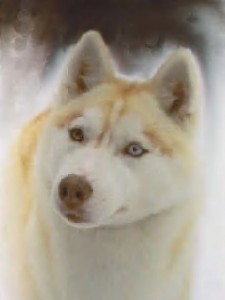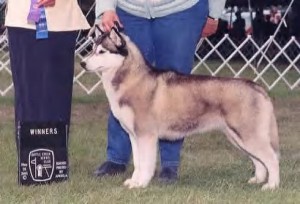Hoping that all fur and non-fur Moms have a wonderful and special day!!!
May 9, 2010
April 20, 2010
Reporting Internet hacking
There seems to be a rise in the scams of selling puppies on the internet. There also seems to be a rise in the hacking of websites also. What makes all of this so very terrible is that there really is no way to control and regulate all of this. That is unless you have a ton of money to fight and pay lawyers.
Jess is only one of the multitudes that have become victims. There are a few programs and plugins for websites that protect our pictures and content, but not that many that can protect our customized coding. I know that there is really nothing that can be done to put a stop to it all, but maybe there is something we can do.
Anyone have any ideas??
Dy
April 16, 2010
“Tasia”
 Can. Ch. Nanook’s Eternal Pages of Time, “Tasia”.
Can. Ch. Nanook’s Eternal Pages of Time, “Tasia”.
My most special girl. Though I purchased her as a young adult, and not as a puppy, we bonded immediately. I’d seen her on some video footage, and new I had to have her.
She would lay her head on my lap when I would work on the computer. Rubbing her ears was relaxing to me. She was my constant companion.
She was taken from me too soon. I’d gone to Florida for my sister’s wedding, only to learn that my beautiful Tasia had died while I was away. The vets had seemed to think it was an allergic reaction of some sort… I’ll never know for sure.
But she is on our mantel to remind me of our love, nonetheless.
“Belle”
 Ch. Karnovanda’s Black Beauty, “Belle”.
Ch. Karnovanda’s Black Beauty, “Belle”.
She had many nicknames throughout her life… ‘Perfect One’ … ‘Bootsy-Boots’ …’Belle-Butt’…etc.
Most affectionately known “smarter than me”.
She had floating, amazing movement – graceful.
She ruled the roost, without needing to be assertive, for her 10 year reign.
Her first American points were awarded her based on her merit, and despite my poor handling ability (according to the judge) :).
Loved and missed always.
“Diesel”
Our most sincere condolences to list-member, Kyle, who lost his beloved buddy yesterday in a tragic accident at a dog park.
April 14, 2010
Upcoming Shows
We are excited to announce that “Neo” and “Trinity” (Morpheus X Taylor) are entered in their first shows the end of this month. Not quite as exciting is the fact that they really aren’t ‘ready’ yet… but they’ve gotta learn sometime :). They’ll be going to WV with a professional handler. We are also planning to attend 4-5 days of the New Castle shows in PA the end of May, barring any unforeseens. If you’re in the area and thinking about getting to a show, we’d love to connect!
Thanks!
Hip Dysplasia
The incident rate in Siberians is fairly low – only around 2%, I believe. I’ve only ever had one case pop up in a dog we produced about 7 or 8 years ago, and I was more than surprised to see it, considering all of the relatives were either good or excellent. I wasn’t entirely convinced that the dysplasia wasn’t due to pulling too early, or very rough play with the dog’s companion (an older Siberian). I’d seen photos of the bigger dog dragging the affected dog around as a puppy by her hind legs. But, according to the owner, their vet claimed that it was hereditary. And it IS in the breed. I don’t have those lines, anymore. And I’ll admit – I still don’t worry about it a whole lot. I eventually get them all in for the OFA, but am not as diligent as I am with the eyes. Those get done annually, and sometimes twice a year.
The term hip dysplasia is common in many medium to large breed dogs. Basically, the ball of the hip does not fit properly into the socket. Early detection can occur between 4-9 months of age if noticeably irregular gait begins to occur. The OFA will rate X-rays obtained by a veterinarian on a scale ranging from Excellent to Dysplastic. Only dogs that have received a rating of Excellent or Good should be used for breeding. Environmental factors, such as injury and a lack of proper nutrition can affect this defect. The incidence rate in Siberians is relatively low comparatively, especially for those dogs descending from lines where hip screenings have been performed over generations. Surgeries are available for affected dogs, but with proper care, he may lead a complete and full life.
If you’ve got any background or experience with this defect, I’d love to know your thoughts on how it can be treated.
Thanks!
Eye Defects in Siberians
Hi folks,
Off and on, over the years, we’ve encountered Siberians with hereditary cataracts. To be considered hereditary by CERF (Canine Eye Registry Foundation), there are certain criteria that the cataracts must meet when it comes to our specific breed. Recently, we encountered our first case of Corneal Dystrophy on a 4 year old bitch (previously clear every year). The only other time I’d heard of it was with a former friend who was able to end up with a clear diagnosis after changing the diet of her dog in question, and in a dog I’d co-bred with that same breeder, who was also able to correct it with a change of food. There are, apparently, 5 types of CD, all considered ‘hereditary’, but with 4 & 5 being the ‘bad’ ones. We were told by the vet that confirmed her initial diagnosis for us that because it was type 3, that we could use ‘breeders discretion’ and breed her, especially since we had data to suggest it wasn’t an issue in the line. He did not feel that food-type would have an impact on her case. We opted to have her spayed and put in a great pet home…. but we do have a dog who has a non-hereditary cataract and has been cleared by CERF, that I don’t feel should be pet-homed. That’s a tough pill for some breeders to swallow, because they aren’t clear on the difference between hereditary and non-hereditary defects.
So – If you’ve had any experience with eye defects, I’d love to hear more information.
Below is some additional information about some eye defects in Siberians. I should probably include Glaucoma – even though I’ve only ever heard of a handful of cases over the years, but for now, we could focus on these three…
Eye diseases are common in Siberians. The three most frequently diagnosed eye defects are Cataracts, Progressive Retinal Atrophy (PRA), and Corneal Dystrophy. To my knowledge, research has yet to produce information verifying the mode of genetic inheritance for each, and in some cases they may be environmentally influenced. However, they are still of great concern to reputable breeders. Many backyard breeders are unaware that their dogs are affected because there are no apparent signs that the diseases are present. They usually have to be diagnosed by a Canine Ophthalmologist.
Corneal Dystrophy: This condition affects the cornea of the eye. A cloudy ring will develop around the center of the eye. It usually shows up between 7 months and 3 years of age.
Hereditary Cataracts: Cataracts are the most common eye problem for the breed. The lens of the eye becomes ‘cloudy’. It will usually show up between 9 months and 2 years of age. In some cases, if serious, cataracts can be progressive and ultimately cause blindness, but typically, you would be otherwise unaware of the defect.
Progressive Retinal Atrophy (PRA): Progressive retinal atrophy is characterized by deterioration of the retina. It can cause blindness, dilation of the pupil, loss of visual cells, and other retinal abnormalities. It is passed along through autosomal recessive modes of inheritance
Insight welcome!
Epilepsy
Hi everyone,
In the past, we’ve had some ‘lines’ of dogs that we found were producing cases of epilepsy (seizures determined by a vet not to be due to a specific cause). We were fortunate to have never have had a dog with this issue before, so it was more difficult for me to advise those who were encountering it. From what I gathered, it was typically manageable by medication, but – depending on the severity, could be difficult to control.
For members of this group who have had experience with dogs who have this condition, can you provide any information, or educational resources you found to be helpful?
Thanks,
Jess
What defines reputable breeding?
Hi all,
I am seeking clear delineation on what separates reputable breeders from back-yard breeders and/or puppy mills. I have my views, but I truly don’t think anyone has the same picture in their heads when this topic is discussed. Sure, you can review the information on parent club sites, but it has been my experience that folks will put their own twist on things to suit their needs. I’ve heard otherwise reputable breeders described as being puppy mills based on things not in the parent clubs’ outline, such as: number of dogs owned, accidental breedings, who they ‘hang out’ with, and because there was a full moon :). Furthermore, some people suggest it is inappropriate to breed a female past age 6, while others feel it’s okay to breed past age 9, if she is healthy. You can’t make everyone happy, but I would like to narrow the field down a bit and try to learn more about the wide range of varying expectations people hold when it comes to this subject.
Your thoughts/insights would be most welcome!
Thanks!
Jess